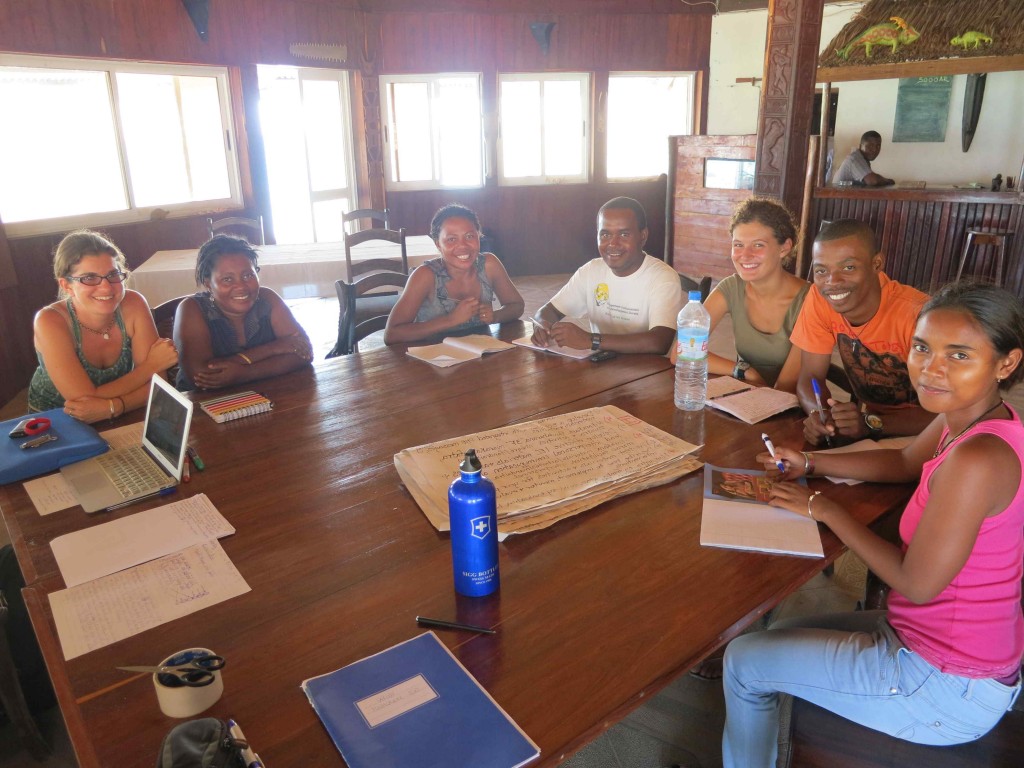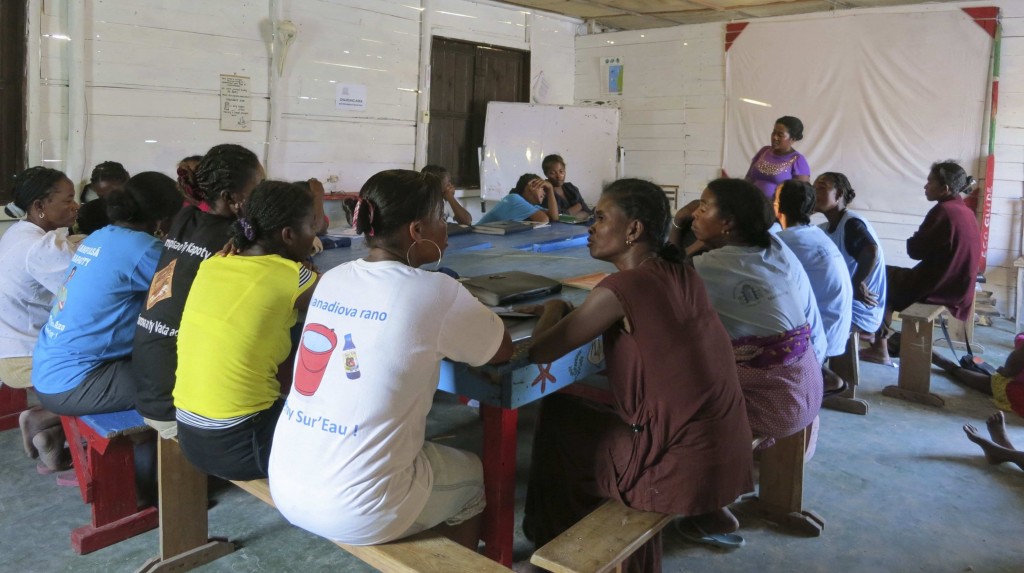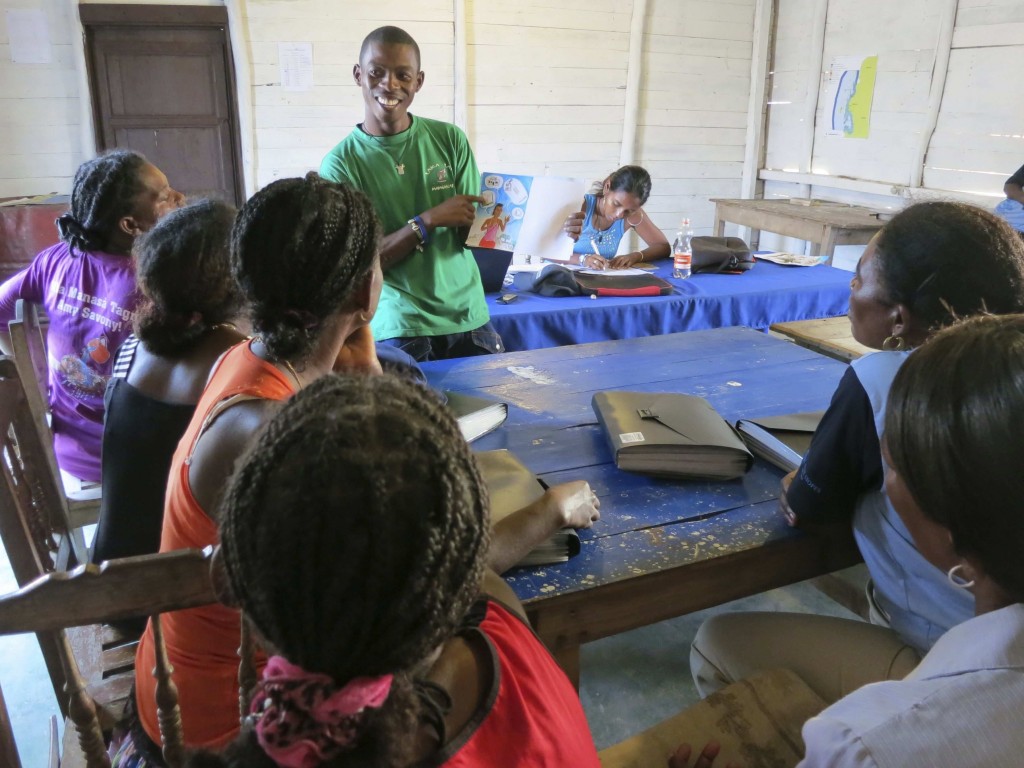By Caroline Savitzky, Safidy (Community Health) Programme Coordinator, Velondriake, Madagascar
Behaviour change is hard. Anyone who has tried to stick to a new year’s resolution, whether it’s quitting smoking, eating well or being more patient, knows this to be true; especially when it comes to health behaviours. But one thing I have learned with Blue Ventures over the last year and a half is that we never stop with the word “hard”. In fact, it’s usually a perfect place to start. And so, our community health team is doing just that.
Over the six years since the Safidy programme began, we have developed a variety of integrated health and conservation education activities. Blue Ventures staff across all programmes, along with community-based distributors of health products, give presentations and organise film projections, community festivals and youth club sessions. Until recently, most of these activities were focused on information dissemination and awareness raising, and our 2013 health survey confirmed what we see every day: health knowledge levels are now high in our partner communities. This is a vital first step in improving health, yet as is often the case and as we all know with our own new year’s resolutions, knowledge and awareness do not automatically result in healthier practices. For example, 90% of people surveyed in 2013 knew that STIs/HIV are a risk of unprotected sex, yet only 15% of people surveyed used a condom last time they had sex.
As we start the new year, it’s time for the Safidy team in Velondriake to build on this strong foundation of knowledge to promote healthy attitudes and behaviours, and to create the supportive environment needed to maintain them. We therefore held a one-week workshop in September 2013 to provide the time and space to develop our behaviour change communication (BCC) strategy. In order to do this, we began by assessing which key practices would have significant health benefits while also being feasible and appropriate to focus on. Secondly, we tried to garner a comprehensive understanding of the reasons supporting and preventing behaviour change, including motivations and barriers to adopting and sustaining healthier practices. Thirdly, based on these discussions, we looked to create an evidence-based and locally-driven programme of work to support behaviour change in our partner communities, with consideration of how to monitor and evaluate the impacts of these activities.

Workshop participants from left to right: Caroline (Safidy programme coordinator and workshop facilitator), Balbine (Safidy community organiser), Viviane (BV education programme), Misbahou (visiting guest from NGO Dahari), Louise (medical elective student), Mahasoa (Safidy health education specialist), Laura (Safidy midwife and clinical technician)
Drawing on the breadth of our team’s experience, and combining information from my previous work in HIV-related BCC (with training from IntraHealth and Peace Corps in Namibia) and graduate coursework in health promotion along with PHE-specific BCC materials from the BALANCED project, we had a hugely beneficial week of learning and discussion. This training was grounded in and sensitive to the realities of our partner communities, and geared specifically towards our programme priorities.
Together we learned about behaviour change theories and stages, material creation and testing, and group dialogue facilitation techniques. We explored the numerous factors that influence health practices such as knowledge levels, peer influence, community attitudes, local traditions and beliefs, relationship dynamics, and the availability and cost of services or health products. In discussing barriers to condom use, a variety of challenges were raised including the value of intimacy communicated through skin-to-skin contact and issues of trust that often arise if a partner suggests using a condom. By bringing up these and other challenges, we were able to explore positive ways of promoting condom use, offering mutual protection as part of caring and affectionate relationships.
The workshop covered a lot of ground within just one week; the enthusiasm and interest of everyone involved was palpable and unwavering, and we even started to develop some material and activity ideas right there and then. For example, directly following the discussion about how to increase condom use, Viviane came up with a potential message that everyone immediately loved: “Life is sweet, use a condom.” In one simple phrase, she captured our approach; using positive and clear messaging.
What came out of this BCC training was a straightforward plan with five clear behaviour change / service access priorities for Safidy, each of which has enormous potential health benefits for our partner communities:
1) Increase condom use and preventing STI transmission; particularly among youth
2) Ensure full access to voluntary family planning services; particularly youth-friendly services with a wide variety of contraceptive options
3) Increase the proportion of women breastfeeding exclusively for six months following birth
4) Increase the number of pregnant women who go for antenatal sessions with community health workers and the Safidy midwife
5) Increase hand washing with soap or ash at all necessary times
Are these lofty goals? Of course. Are they attainable? Yes!! How so?
Throughout the final months of 2013 we began to practise facilitation techniques, increase our work with small groups of youth, introduce these new priorities and approaches to our network of community-based distributors, and prepare new education materials for pre-testing with them. Now, as our team all return re-energised from their Christmas holidays, we will be taking time to develop and implement our new BCC strategy with the objective of achieving measurable change in these five areas.

Discussing our behaviour change communication strategy with the community-based distributors
For each priority we are developing materials along the behaviour change spectrum, from increasing knowledge and changing attitudes to supporting the sustained adoption of healthier practices. These materials include things like visual discussion aids, theatre sketches and radio spots, and small group session plans. All of our community-based distributors will be involved in implementing new activities, in partnership with local youth clubs and women’s groups, and we will continue to integrate these activities and messages into Blue Ventures’ conservation programmes.
We know that behaviour change doesn’t happen in a vacuum. It must involve actions at many levels as the determinants of health-related behaviour include structural, community, interpersonal and individual factors. As we implement our education activities, we will therefore simultaneously be working to break down barriers to behaviour change and ensure that the social environment – including community-wide attitudes – is supportive of these healthier practices. For example, we will continue to ensure that our midwife and community health workers are available and reliable for antenatal consultations and education sessions, that contraceptive supply chains are uninterrupted, that condoms are accessible and affordable, that our service model is responsive to youth, and that all community members (partners, elders, children, etc) are supportive of these behaviour changes.

Mahasoa pre-testing new behaviour change communication materials with our community-based distributors
Our approach to behaviour change is based on strong partnerships: with health authorities, local leaders and officials, other health service providers, conservation organisations and, most of all, with community members who are leading this process. Partnerships help us to focus clearly on where we can be most effective and identify collaborations that benefit communities, ensure that all of our materials and messages are delivered in positive and inclusive ways, and help us to evaluate the impact of education activities.
We also find ourselves in a fortunate position to build on the phenomenal work of other health and PHE programmes, many of which shared their best practices at the International PHE Conference and International Conference on Family Planning in Addis Ababa last November. We look forward to continue exchanging learning with these organisations, and plan to incorporate and adapt aspects of their work in our context, while also communicating our experiences back for others to build upon.
I think that our process so far can be summed up like this: Behaviour change is definitely hard. Behaviour change requires immense and unconditional support, respect, sensitivity, void of judgment and full of patience. Behaviour change should relate directly to the health needs of our partner communities and must be culturally appropriate, using accurate and positive messages. Behaviour change must also start with ourselves. So as we look towards 2014, let’s not just make new year’s resolutions but let’s work together to achieve them. Let’s find the resolve to come together and improve our lives, one decision at a time.

